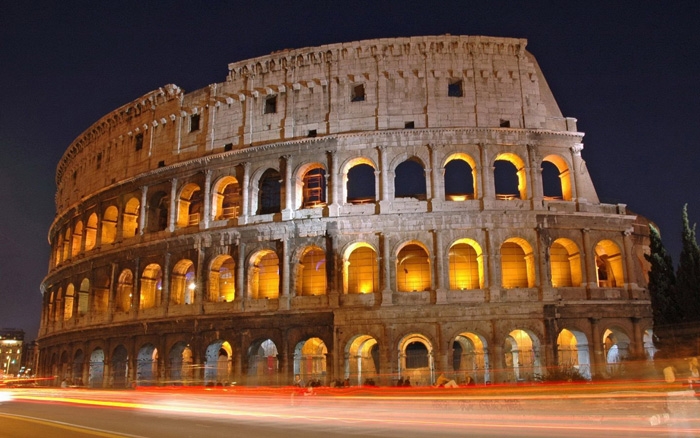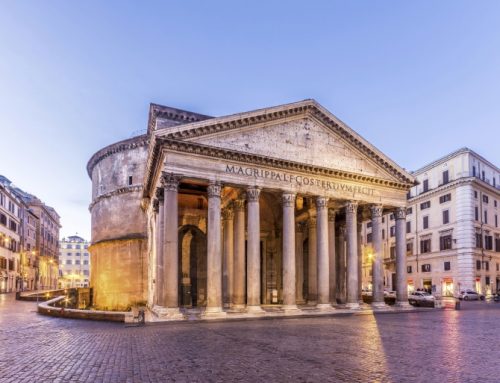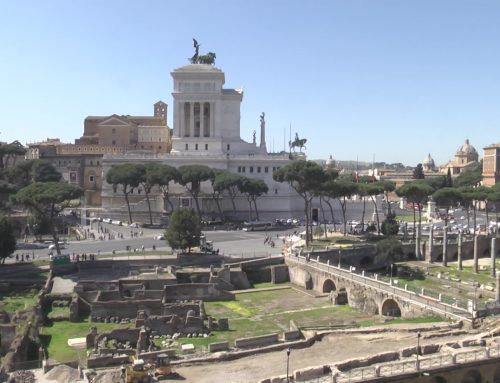Treasures of Rome: THE COLOSSEUM
The ruins of the Colosseum are an eloquent witness to the greatness of ancient Roman civilization, and the same time to its immorality and impermanence. Pope John Paul II characterised it in telling words when he called it
“this tragic yet glorious monument of imperial Rome, a silent witness to power and dominion, a testimonial to moments of life and of death, where cries of blood (cf. Jn 4:10) seem still to ring out, together with words of peace and forgiveness.”
Greatness and cruelty
The Flavian Amphitheatre, to give the Colosseum its original name, is a reflection of the genius of Rome, with its capacity for carrying out stupendous undertakings while attending to practicalities down to the last detail. Everything about this vast construction is designed to ensure that its imposing dimensions detract nothing from its beauty or its utility. Architectural balance is achieved through the three tiers of arches in which the spaces are carefully distributed to give a sense of lightness.
Practical common sense is evidenced by thousands of details. More than eighty different entrances enabled the amphitheatre to be filled with people or evacuated in just a few minutes; the distribution of seats was calculated to give a full view of the arena from each of the fifty thousand places available; awnings could be extended by a team of a hundred soldiers, to protect the audience from sun or rain as needed; and there was a complex network of underground passages, with pulley-operated lifts to haul the gladiators or wild beasts up to the arena.
This huge construction took eight years to build, and as many as twelve thousand slaves may have been used as labour. Many of these would have been Jews, taken prisoner by Titus after the destruction of Jerusalem in the year 70 A.D. The new Amphitheatre was inaugurated in 80 A.D., with a hundred days of spectacles and festivities, during which hundreds of gladiators and around five thousand animals were killed in the arena. Also around that time the first naumachiae were held: these naval battles, enacted by flooding the whole of the arena with water, must have caused a huge impact on the Roman population by their novelty.
Successive emperors competed to offer more grandiose spectacles every year. Seneca had already lamented the spiral of violence and inhumanity that this type of entertainment gave rise to. The populace demanded ever more sensational events, interested only in blood and killings, the more cruel and sophisticated the better.
 |
|||
| The Martyrdom of Saint Ignatius of Antioch | |||
A noble martyrdom “in Amphitheatrum”
A moving example of how the early Christians faced martyrdom is given to us by St Ignatius of Antioch, who died in the times of the Emperor Trajan. A convert from paganism, Ignatius was St Peter’s second successor to the episcopal see of Antioch. In 107 A.D. he was arrested, condemned ad bestias – to be killed by wild beasts – and sent to Rome under military guard for execution.
Of his long journey from Syria to Rome we know a great deal through the historian Eusebius of Caesarea and, especially, the seven letters written by St Ignatius himself to the churches of seven different cities, to strengthen them in their faith and forewarn them against the Gnostic heresies which were being propagated at that time. All his letters begin with the greeting “From Ignatius, also called Theophorus (‘God-bearer’)”.
St Ignatius was full of God, and this is reflected in the tone of his letters. “Abundant happiness through Jesus Christ, and His undefiled grace” is his greeting to the Ephesians, and he sends the Philadelphians a greeting “in the blood of Jesus Christ, who is our eternal and enduring joy”. The reasons for his happiness were totally supernatural, since the future martyr knew what awaited him, and the soldiers who guarded him were far from gentle. “From Syria even unto Rome,” he wrote, “I fight with wild beasts, by land and sea, by night and by day, being bound amidst ten leopards, I mean a company of soldiers, who only grow worse when they are kindly treated. But I am the more instructed by their injuries [to act as a disciple of Christ].”
St Ignatius rejoiced to share in Christ’s Cross, and ardently desired that his identification with our Lord should be completed in martyrdom. Accordingly he begged the Christians not to intercede for him with the Roman authorities, and expressed his desire that the wild beasts would devour him speedily, “and not deal with me as with some, whom, out of fear, they have not touched.” There were some famous cases in which the voracious animals had refused to attack Christians, or, to the spectators’ astonishment, had even lain down meekly at their feet. Long-standing traditions attest this of St Martina, St Alexander and St Marinus, among others.
The Bishop of Antioch was thrown to the lions in the Colosseum. Thus was fulfilled his expressed desire: “I am God’s wheat, and I must be ground by the teeth of wild beasts to become the immaculate bread of Christ.”
 |
|||
| Stone plaque commemorating the consecration of the Colosseum as a holy place | |||
After the horrible spectacle
was over the Christians managed to rescue some of the martyr’s bones. These they preserved with great reverence and later sent back to Antioch. As St John Chrysostom said to the faithful of Antioch, “You benefited from his bishopric, and those of Rome admired his martyrdom. The Lord took this priceless treasure from you for a short time to show him to the Romans, and has now returned it to you increased in glory.” In the seventh century, for fear of Saracen invasion, the relics were once more taken to Rome, and today repose in the church of St Clement. Pilgrims may go there, as St John Chrysostom recommended, “to draw spiritual fruit from these holy remains, since they are like a treasure from which part may be taken away without diminishing the whole.”
The path of ordinary life
 |
|||
| The Cross at the Colosseum | |||
Although the Circus Maximus, Nero’s Circus, and other Roman sites were also the scenes of many martyrdoms, in 1794 Pope Benedict XIV consecrated the Colosseum as a holy place, sacred to the memory of the Passion of Christ and the sufferings of the martyrs. That same year he had the fourteen Stations of the Cross placed around the arena.
People entering the Colosseum today are immediately confronted with a large black wooden cross, inviting them to pray. On this spot, before the instrument of our Lord’s Passion, which also recalls those who gave their lives for Christ, desires for greater self-giving arise very naturally, desires of overcoming one’s own selfishness once for all, desires of an increased love of mortification in all Christians. With the help of God’s grace, these holy aspirations can come to fruit in ordinary, daily life. “Many who would willingly let themselves be nailed to a Cross before the astonished gaze of a thousand onlookers cannot bear with a Christian spirit the pinpricks of each day! Think, then, which is the more heroic.”
Like the martyrs, we Christians have to have a burning desire to fulfil God’s Will and show him our love even through sacrifice, undertaken with joy, because “ Mortification is not pessimism or bitterness. Mortification is useless without charity. That is why we must seek mortifications which, while helping us develop a proper dominion over the things of this earth, do not mortify those who live with us. A Christian has no warrant to act as torturer, nor should he allow himself to be treated as a feeble wretch. A Christian is someone who knows how to love with deeds and to prove his love on the touchstone of suffering. But, I must remind you, mortification does not usually consist of great renunciations, for situations requiring great self-denial seldom occur. Mortification is made up of small conquests, such as smiling at those who annoy us, denying the body some superfluous fancy, getting accustomed to listening to others, making full use of the time God allots us… and so many other details. We find it in the apparently trifling problems, difficulties and worries which arise without our looking for them in the course of each day.”






Leave A Comment
You must be logged in to post a comment.